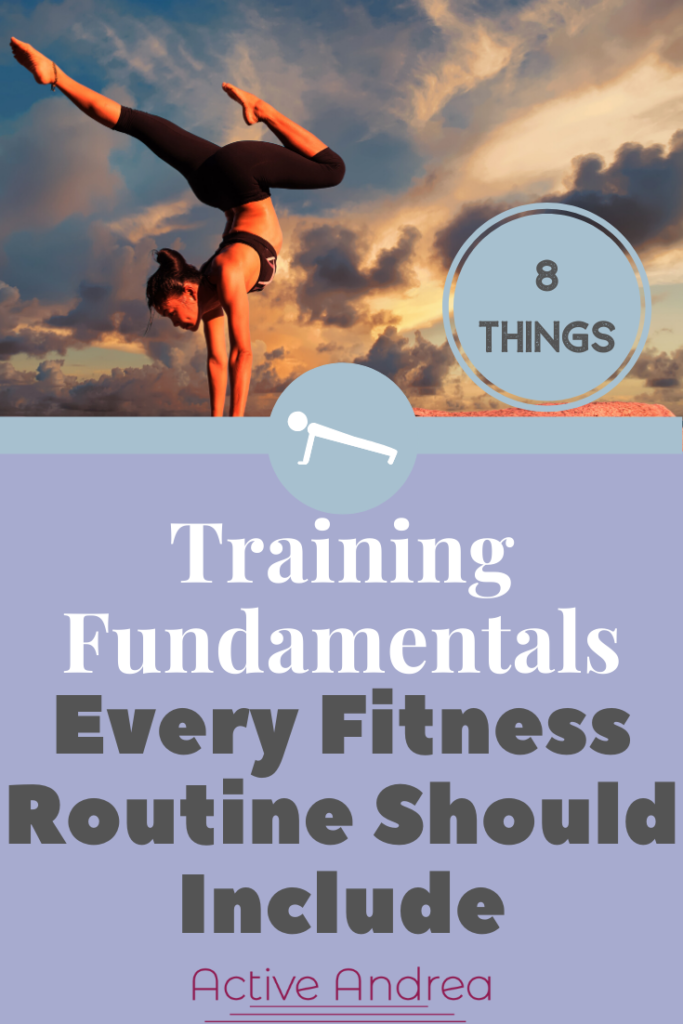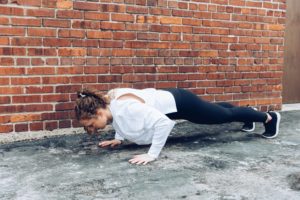Nowadays, we are overwhelmed with options, from what to watch on television (somehow I still end up watching reruns of The Office…) to online shopping for a pair of sneakers.
When it comes to exercise, forget about it! As someone who loves to move in different ways, it can be a real pickle deciding how to workout.

What I’ve learned as a personal trainer, however, is that there are some basic elements every fitness routine should include. The next time you’re deciding on a workout program, make sure it contains all these elements.
Core Strengthening
By core, I mean your interior and exterior abdominals, your obliques, your back muscles, and your pelvic floor. These muscles are crucial for any type of athletic performance, from driving a golf club to running a 5k.
Your program should include a variety of core strength exercises, like isometric holds (think planks, yoga boat holds, hollow holds) to more dynamic movements like mountain climbers or bear crawls.
Standard crunches are fine but don’t make them your only core exercise. Crunches only strengthen one part of the body, whereas full body core work helps us build better neuromuscular connections throughout our entire system. This prepares us for all sorts of athletic movements.
Isometric holds like planks are also great because they build core endurance and work other parts of the body like the back, glutes, hamstrings, and quads.
The better our core endurance, the longer our core can support us for things like marathon races or holding a Warrior I in yoga class.
Glute Strengthening
Don’t even think about neglecting the glutes. Our butt muscles are some of the biggest muscles in the body and help us with all kinds of movements. Because many of us sit the majority of the day, our glute muscles often get neglected and weak if we don’t give them attention.
Glutes are especially important for runners. If not properly cared for, weak glutes can lead to hamstring tightness and injury.
Your fitness program should incorporate dynamic glute exercises like lateral walking squats, isometric glute holds (like a bridge pose), as well as glute + hamstring exercises like deadlifts or bridge lifts.
Hip Flexibility and Health
Sitting all day doesn’t just weaken our glutes; it leads to tight hip flexors. As a runner, I can say from personal experience that not properly stretching your hip flexors after a run and then sitting all day can lead to serious tightness.
Your exercise program should properly warm-up the hip flexors (think leg swings, runner’s lunge stretches) and incorporate hip stretches after you exercise. Lying pigeon pose or a yogi squat are great ones.
Cardiovascular Training
If you’re someone who follows a weight-lifting routine, make sure you’re incorporating enough cardio into your routine. Cardiovascular exercise is so important for our overall health! Not only does it help decrease risks of heart disease, high blood pressure, and reduce mental stress, but it improves our endurance, making us better well-rounded athletes.
Incorporate cardio into your fitness routine 2 to 3 times a week at minimum. If you love weightlifting, try circuit training, moving from one exercise to the next without resting. Other options include high-intensity interval training, either on a treadmill, bike or with bodyweight exercises, or steady-state cardio like a long walk or run outside.
Stretching
Without a proper stretch routine, our fitness regime could take a serious toll on our bodies. Ideally, you stretch a little every day. At the very least, take time after your workouts to stretch all the parts of the body you worked out.
Check out my post-run stretch routine here.
If you work a desk job, it’s important to give extra attention to stretching your hips, calves, shoulders, chest, and quadriceps. Sitting in a chair hunched over a keyboard all day tightens these muscles.
Balance Training
Does your fitness routine incorporate balance training? Often an underutilized but powerful training option, balance training strengthens our stability systems, from our core to our ankles. With better balance, we have better body awareness and control.
Yoga and Pilates are great ways to incorporate balance training into your routine. Other options are to do regular strengthening exercises, like a bicep curl or overhead press, while standing on one leg. If you can’t quite do it on one leg, stand on a foam pad with two feet.
Warm-Up & Cool-Down
Always do a warm-up and cool-down! I totally get that when you squeeze a workout into a busy day, it’s tempting to skip extra steps. But you will achieve better longevity in your training by warming-up your muscles properly and giving them some attention with post-workout stretching.
Your warm-up doesn’t have to be long. The key is to get your heart pumping and feel warmer. If you’re into yoga, do some cat/cows and a couple of Sun Salutations. Or take five minutes to climb up and down a flight of stairs or jog around the block.
For a cool down, stretch with either static stretches held for 15 to 45 seconds or more dynamic stretches with 1 to 2-second holds.
Lower Intensity Days or Rest Days
To stay fit and healthy, you don’t need to workout hard seven days a week. You should workout high intensity at a maximum of three days a week, with two to three days being low to medium intensity. Save one day for rest or a low-intensity restorative yoga class or a long walk.
How to Apply these Elements to Your Exercise Routine
If you like…Dance Cardio workouts
As long as each session warms you up and cools you down effectively, with time for stretching (especially those calves, hamstrings, quads) and dedicates some time to sculpting the behind and core, dance cardio is a fantastic workout routine!
If you like…Spin classes
Spin classes are fantastic cardio workouts. Most modern spin studios like Flywheel, Cyclebar, and SoulCycle have short circuits in the last fifteen minutes of class to work your arms, which indirectly works your core as well. Cycling itself improves core stability if you have proper form.
If you’re doing spin classes multiple times a week, you’ll have to do a bit of extra stretching, balance and mobility training on your own. Spin bikes put our hip flexors in the same position as when we sit, tightening our already tight hip flexors from all the sitting we do. Also, based on all the spin classes I’ve been to (which has been a lot) the cool down stretch portion of class only holds stretches for about 5 to 10 seconds. Ideally, you hold a static stretch for 30 seconds or do a dynamic stretch with a 1 to 2-second hold.
If spin class is your jam, great! But to make sure you’re taking care of your body, I’d recommend going 3x per week and spending one or two days doing more traditional resistance training that includes core and glute work. A yoga class and a short nightly stretching routine would also be wonderful additions.
If you like…Split Routine Weightlifting
Split routine is when you divide your days between body parts, like focusing on legs on Mondays and chest, back, and triceps on Tuesdays. It’s a great way to train if you have limited time and want to really burn out a muscle group within a certain session.
Your weight-lifting program should have cardio days – like a 30-40 minute low-intensity cardio session 2 to 3 times a week or a short HIIT workout 1-3 times a week – balance training, a rest day, and time for stretching and foam rolling. Foam rolling is especially important with intense weight lifting routines that make your muscles sore for days afterward.
If you like…Marathon Training
Marathon training requires a high volume of cardiovascular training and seemingly little time for anything else. But you will be a better, faster runner with fewer injuries if you can make time for the extras.
Strengthening your core and glutes is key, as are single-leg balance exercises like Bulgarian split squats and Warrior III holds. Make sure you warm-up well, especially before harder runs, and stretch and foam roll.
If you don’t have a program…Try Faster Leaner Stronger
My Faster Leaner Stronger program provides a fully comprehensive training program so you can think less about your workout. All these fitness fundamentals are included to get you training and moving like an athlete.



